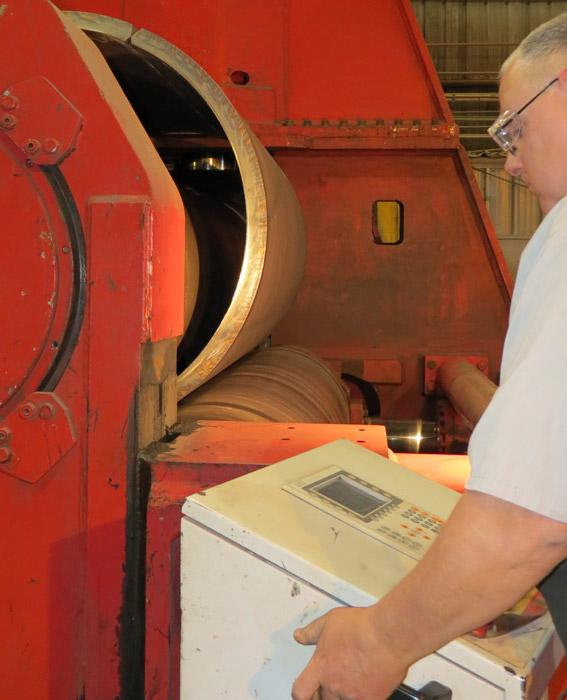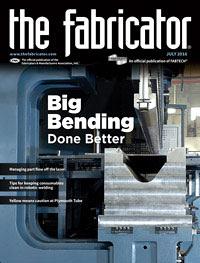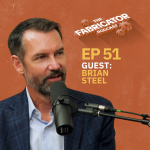Senior Editor
- FMA
- The Fabricator
- FABTECH
- Canadian Metalworking
Categories
- Additive Manufacturing
- Aluminum Welding
- Arc Welding
- Assembly and Joining
- Automation and Robotics
- Bending and Forming
- Consumables
- Cutting and Weld Prep
- Electric Vehicles
- En Español
- Finishing
- Hydroforming
- Laser Cutting
- Laser Welding
- Machining
- Manufacturing Software
- Materials Handling
- Metals/Materials
- Oxyfuel Cutting
- Plasma Cutting
- Power Tools
- Punching and Other Holemaking
- Roll Forming
- Safety
- Sawing
- Shearing
- Shop Management
- Testing and Measuring
- Tube and Pipe Fabrication
- Tube and Pipe Production
- Waterjet Cutting
Industry Directory
Webcasts
Podcasts
FAB 40
Advertise
Subscribe
Account Login
Search
The human side of the skilled-labor crisis
Watching a plate rolling operator in action is to see the humanity of metal forming
- By Tim Heston
- July 8, 2016
- Article
- Bending and Forming
Walk into a custom plate rolling operation and you see the epitome of concentration and teamwork. In an initial-pinch, fixed-top-roll, three-roll machine, the punch roll provides the pressure while the bending roll’s position determines the geometry. Every time the operator raises and lowers the bending roll, the position of the moment of bend changes, and setting it just right is a delicate dance.
A plate rolling operator and his helper aim to achieve a parallel line of pressure across the workpiece. It’s easier said than done, especially when you consider the nature of the machine. Like a brake, plate rolls are rigid near their ends and deflect near the center—hence the need for crowning, with roll diameters thicker in the middle than near the machine frame.
Does the workpiece require shimming to eliminate the barreling or hourglassing effects of improper crowning? By how much do you compensate, considering the amount the rolls are crowned in the center? Then there’s the pinch pressure. How will changing the pinch pressure affect the material? A stainless workpiece might maintain its integrity with significantly increased pinch pressure, but under the same pressure, a soft aluminum may succumb to “pie doughing,” akin to thinning out a piece of pie crust. What kind of supports does the workpiece require? Gravity works, especially when rolling thin sheet into a large-diameter cylinder.
A skilled plate roll operator knows these questions need to be asked and, through finesse, tweaking rolling parameters a little here and a little there, discovers the answers.
This industry needs more of that.
According to the Bureau of Labor Statistics, despite news of layoffs, unemployment in manufacturing remains low, at less than 5 percent, which is down from a high of nearly 13 percent in 2010, and similar to what the rate was between 2005 and 2007.
Most significant, the BLS reported that the ratio of openings to hiring in manufacturing is at an all-time high. Companies still can’t find the people they need.
The problem isn’t simple, and it’s not the same in all areas of the country. In a 2013 report the Boston Consulting Group estimated that the U.S. was short between 80,000 and 100,000 skilled manufacturing workers. Nevertheless, the problem seemed to be highly localized. Only a handful of regions (this being 2013, many were tied to oil and gas) seemed to have severe skills gaps. As the report stated, “90 percent of the biggest manufacturing areas do not show evidence of significant manufacturing skills shortages.”
This makes sense. Consider the welding trade. I’ve talked with various skilled welders from across the country over the years; some can find jobs in a heartbeat; others struggle in an area that’s overflowing with trained welders looking for work.
Regardless, “trained” isn’t the same as “highly experienced.” In many areas welders and other skilled fabricators who have worked decades are preparing for retirement. Now, all of a sudden, fabricators need to replace that talent. Ideally, they should have hired employees several years ago to give these people time to learn the trade. But thanks to the Great Recession, not to mention the overall pressure of global manufacturing, fabricators weren’t in a position to hire.
Some shop managers have told me they’re happy when they find people who stay off drugs and show up to work consistently. Then when these employees do become experts, they keep their knowledge to themselves and sometimes use their unique capabilities to their advantage; they know a good plate roller, press brake operator, or welder is tough to find. They know they have job security, so why put in the extra effort?
Of course, this is all from the manager’s perspective; employees have another. Like in any industry, some employers are better to work for than others.We’ve covered various ways in which fabricators try to attract the best, to be the employer of choice. The details are various, but the strategies usually involve giving a voice, career path guidance, and some sense of security to permanent employees. They want employees to know that they aren’t just a number in a head count to be shrunk and expanded as demand dictates. This is real life, and a layoff can’t be avoided entirely, but employees should at least know that managers consider it a method of last resort.
But there’s another wrinkle to the skilled-labor story. It goes back to the plate rolling operator, welder, press brake technician, or any person who does more than stand by a machine and push buttons. The more I watch, talk with, and learn from these individuals, the more I perceive the close relationship between the operator, the machine (or cutting torch or welding gun), and the workpiece.
Operators need to know math, of course. A press brake operator, particularly one working on an old machine, needs to know his way around trigonometry.
Still, so much in STEM education fosters an “if this, then that” way of thinking. If you write this code, then the software does this. If it doesn’t do it, you then debug and perfect it until it works as it should. Ironically, machines are really good at “if this, then that” logic. If a person learns to think like code, his or her job could well be automated in the years to come.
But many in old-school metal fabrication don’t follow the “if this, then that” way of thinking. Certain processes are far too complex. The mills still haven’t found a way to produce sheet or plate that comes in a precise, homogenous thickness and strength. So when you cut, form, and weld it, there’s variation. If you set a plate roll like this, that might happen or it might not. It depends. You can’t debug it to make it work for all the jobs that follow, even if those jobs are identical (which, in custom fabrication, is rare).
An old-school brake operator can look at a blank and in his head see how it will fold. A plate rolling operator will know just how much to adjust the pinch and bending rolls to get the radius he needs. This sense takes time to develop.
The trick is to identify this sense early, particularly in those who are easy to work with and engaged in the process. Metal fabrication needs technical skill, but reading the machine and workpiece remains very much a human endeavor. That humanity is what makes this industry so great.
About the Author

Tim Heston
2135 Point Blvd
Elgin, IL 60123
815-381-1314
Tim Heston, The Fabricator's senior editor, has covered the metal fabrication industry since 1998, starting his career at the American Welding Society's Welding Journal. Since then he has covered the full range of metal fabrication processes, from stamping, bending, and cutting to grinding and polishing. He joined The Fabricator's staff in October 2007.
subscribe now

The Fabricator is North America's leading magazine for the metal forming and fabricating industry. The magazine delivers the news, technical articles, and case histories that enable fabricators to do their jobs more efficiently. The Fabricator has served the industry since 1970.
start your free subscription- Stay connected from anywhere

Easily access valuable industry resources now with full access to the digital edition of The Fabricator.

Easily access valuable industry resources now with full access to the digital edition of The Welder.

Easily access valuable industry resources now with full access to the digital edition of The Tube and Pipe Journal.
- Podcasting
- Podcast:
- The Fabricator Podcast
- Published:
- 04/09/2024
- Running Time:
- 63:55
In this podcast episode, Brian Steel, CEO of Cadrex Manufacturing, discusses the challenges of acquiring, merging, and integrating...
- Industry Events
16th Annual Safety Conference
- April 30 - May 1, 2024
- Elgin,
Pipe and Tube Conference
- May 21 - 22, 2024
- Omaha, NE
World-Class Roll Forming Workshop
- June 5 - 6, 2024
- Louisville, KY
Advanced Laser Application Workshop
- June 25 - 27, 2024
- Novi, MI
































